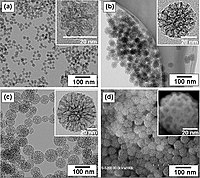
Photo from wikipedia
Abstract Surface modification of Zirconium (Zr) with Zirconia (ZrO2) nanotubes (NTs) was performed using a two-step electrochemical anodization to investigate the role of such a modified surface in apatite formation… Click to show full abstract
Abstract Surface modification of Zirconium (Zr) with Zirconia (ZrO2) nanotubes (NTs) was performed using a two-step electrochemical anodization to investigate the role of such a modified surface in apatite formation and the inhibition of bacterial growth on Zr implants. Pore size at the surface of the NT arrays was controlled, along with the NT length, by varying the 2nd-step anodizing time duration. Nearly four-fold changes in the pore size were achieved by varying the anodization at the second anodizing step. The apatite formation on the implant surfaces plays an important role in the osteointegration process, which can be greatly influenced by the morphology and crystalline structure of the surface. XRD analysis of the anodized surfaces identified a mixed phase of monoclinic and tetragonal ZrO2 NTs with the crystallite size decreasing with increased 2nd anodizing time duration. Surface roughness of the ZrO2 NTs decreased with an increase in anodizing time duration. The ZrO2 NTs with the largest pore sizes, and the smallest crystallite sizes (ZrO2-15m) favoured the deposition of a Ca-rich compound on their surfaces following 24 days of soaking in SBF, and showed the highest apatite-forming ability among all studied samples. Antibacterial tests showed that the ZrO2-15m sample exhibited antibacterial properties with 1log10 CFUs/mL reduction of S. aureus and E. coli incubated in a buffer solution for 4 hrs. Loading the NT layer with antibacterial drug led to a complete inhibition of both bacterial species. The rate of drug release was slowed down by dip coating the drug loaded NTs in a PLGA solution. A higher number of dip-coating steps not only slowed down the release of the drug, it also led to a higher suppression of growth in both bacteria. Longer antibiotic exposure and optimized dosage of the drug released from ZrO2 NTs can therefore be managed by modifying the NT morphology and the number of PLGA dip-coating steps.
Journal Title: Ceramics International
Year Published: 2021
Link to full text (if available)
Share on Social Media: Sign Up to like & get
recommendations!